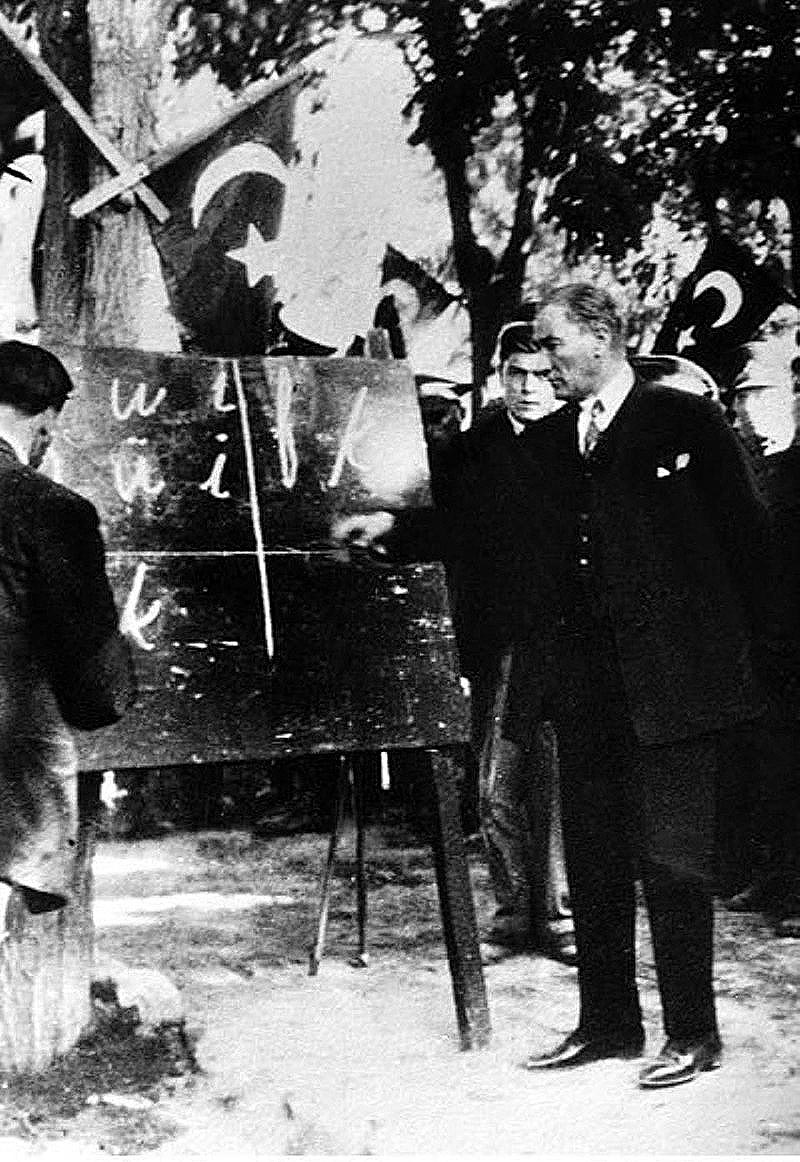Aborted character simplification in the mid-1930s
« previous post | next post »
Great piece on the materiality of language. Part of the difficulty in implementing jiantizi in Singapore was just this: for example, in 1983, years after Singapore had begun introducing jianti, the limited availability of type meant that only 70% of publishers used them. https://t.co/GB9JxiI2wD
— Chien-Wen Kung 龔建文 (@kchienw) October 4, 2024
The path to language / script reform is not always easy, even when it seems to be conceptually well planned. On the other hand, when those who support it strongly take firm, decisive action — witness the replacement of the Arabic script by the Latin alphabet propounded by Mustafa Kemal Atatürk (ca. 1881-1938) in Turkey — it can succeed almost overnight. One of my favorite photographs is this one of the great man going down to the villages himself to teach the people how to write with the alphabet:

Atatürk introducing the new Turkish alphabet to the
people of Kayseri on 20 September 1928 (Wikipedia)
This is quite different from what happened in Korea, where King Sejong (1397-1450) had a brilliant idea for a superior writing system to replace the Chinese characters, but was diffident in implementing Hangul (1446). Still, centuries later, it came to fruition during the 20th century.
In 1504, the study and publication of hangul was banned by Yeonsangun. Its spread and preservation can be largely attributed to three main factors: books published for women, its use by Buddhist monks, and the introduction of Christianity in Korea in 1602. Hangul was brought into the mainstream culture in the 16th century, due to a renaissance in literature and poetry. It continued to gain popularity well into the 17th century, and gained wider use after a period of nationalism in the 19th century. In 1849, it was adopted as Korea’s national writing system, and saw its first use in official government documents. After the Treaty of 1910, hangul was outlawed again until the liberation of Korea in 1945.
What next for hànzì 漢字 ("sinographs; Chinese characters")?
Selected readings
- "Extreme simplification and phoneticization" (11/19/23)
- "Simplified vs. complicated in New York state" (3/18/16)
- "Simplified Bomb" (6/9/09)
- "Simplified vs. Complex / Traditional" (4/23/09)
- "Of toads, modernization, and simplified characters" (8/16/13)
- "Simplified characters defeat traditional characters in Ireland" (8/9/21)
- "Eruption over simplified vs. traditional characters in Hong Kong" (2/24/16)
- "'Chinese — Traditional'" (1/30/11)
- "Hangul: Joseon subservience to Ming China" 5/14/22)
- "A Dartmouth grad's contribution to the development of Hangul" (6/25/15)
- "His Coffeeness" (4/10/14) — in the comments
- "The pragmatic and innovative Choe Sejin — 15th-16th c. Korean phonetician, translator, and interpreter" (4/21/22)
- "Perso-Arabic and Sinitic Literacy" (6/19/09) — in the comments
[Thanks to Geoff Wade]
J.M.G.N. said,
October 5, 2024 @ 7:40 pm
"Only 70%"
Why is almost three-quarters too little?
David Marjanović said,
October 6, 2024 @ 4:03 am
Kayseri is a major city, though, not exactly "the villages".
That's not about the 30s, that's about 1983, shortly after Singapore had officially introduced the PRC's simplified characters. Eventually that worked out.
Chris Button said,
October 6, 2024 @ 6:55 am
"Many of them would simply have been abbreviations commonly found in hand-written texts."
And if only they had just left them as abbreviations, they wouldn't have ironically complicated rather than simplified things.
Wayne Wong said,
October 19, 2024 @ 11:24 pm
Modern publishing technology, with its software fonts, apps, etc., makes it technically easier and less costly for today’s visionary people to take the next step and use Pīnyīn, which additionally has the advantage of not requiring tens of thousands of glyphs to be implemented for every font.
Wayne Wong said,
October 19, 2024 @ 11:28 pm
Pīnyīn is like Hangul for Mandarin.